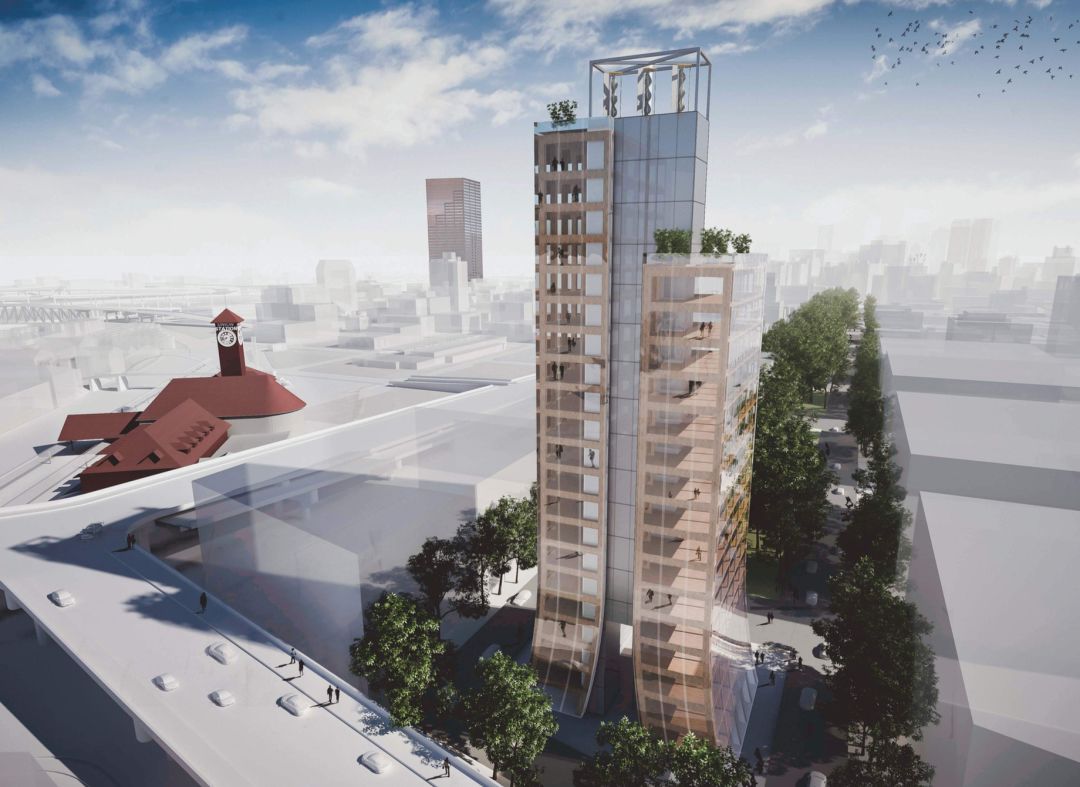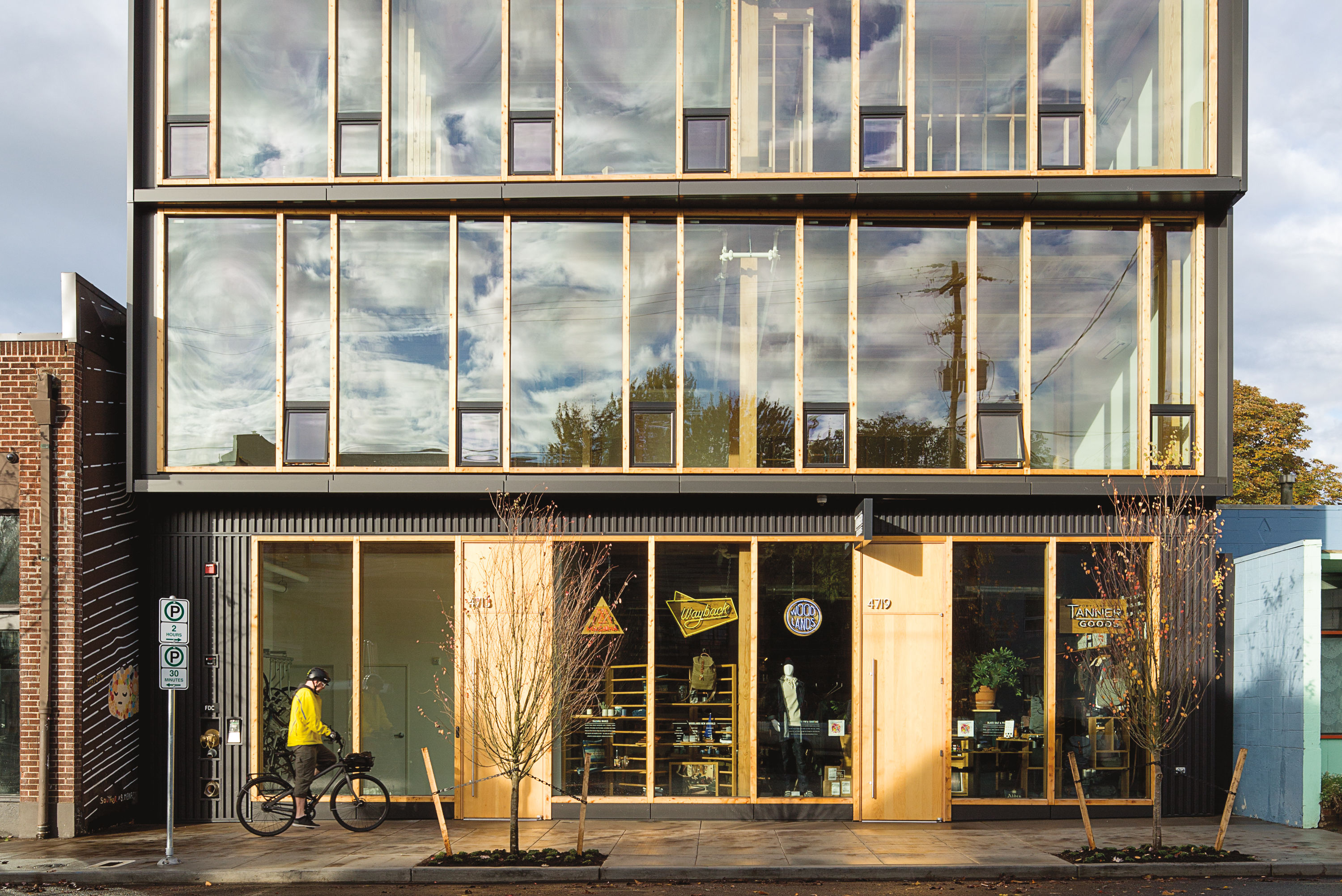Would You Live in This 300-Foot-Tall Wooden Skyscraper?

The Spar
Image: Path Architecture
The tallest timber structure in the country is already underway in Portland. PATH Architecture's Carbon12, standing 85 feet tall on North Williams and Fremont and erected from cross-laminated timber (CLT), could spell the future of design and construction in our city.
Now, there's Spar, a proposed 300-foot engineered timber structure anchoring the North Park Blocks on Northwest Lovejoy. We sat down with the high-rise's chief cheerleader and PATH owner, Ben Kaiser, to talk about replicating timber structures on a grand scale and how the economy and environment might benefit.
What is the Spar?
The Spar is the image we generated for the TedxPortland Talk [last April], and it would be the tallest engineered timber structure in the world, standing at 300 feet tall. As a mass timber structure, roughly 80 percent of its construction material would be CLT with a lightweight steel core at its center.
The Spar would be at the end of the North Park Blocks, located along Northwest Lovejoy. As a city building, it would be fantastic if we could house anything to do with sustainability, such as the Forest Service, USDA, or the City of Portland Sustainability Center. It’s a public building to keep Portland in the front as far as environmental stewardship. To connect the park blocks like that would show real unity in the city.
So, why engineered timber? Why now?
The driver behind all of this is the environmental benefit. At 14 inches thick, CLT retains the same strength as concrete or steel. It performs just as well and weighs 80 percent less. In wood’s growth process, because it is made of carbon through photosynthesis, as a product, it is "sequestered carbon." Rather than generating carbon, it captures carbon. Building sites generate more carbon dioxide emissions than cars, and now we have a building material that can cut 80 percent of that energy output alone and weighs 80 percent less than steel and concrete.
Are there naysayers?
The environmentalist argument [against it] is that building with trees means clear-cutting again, going back in time. Well in fact, most of the CLT products are using trees that are nine inches in diameter or less. We can use smaller diameter trees—second, third, or fourth growth forests. We can use "drought-kill" lumber, trees that have died in droughts. And beetle-kill lumber, standing trees that are dead. We can use discolored wood and dried out dead wood, because it’s layered and laminated, because it’s all buried. Only the bottom layer is exposed and can look nicer. We’re not killing old-growth forests. Rather, with all the forest fires, there’s an effort nationally to thin out all these forests.
In addition to the resource we have, we can stimulate the economy to lessen the rural and urban divide by fabricating buildings in urban centers with rural products. The timber industry in Oregon is still down 50 to 60 percent from pre-recession, and now we have an industry that we can run together. Ultimately, there’s a big triangle of success here. Nothing convinces me otherwise.
Does the design have any other unique features?
What I’ve been thinking about a lot as an architect is how can buildings take care of you when you’re not in the building. We’ve been making advances in seismic detection. For instance, the building will send out a text to alert us of an earthquake. We’re working with large testing companies.
We’re thinking of advancing structural building monitoring. In the joints of the One North building [located on North Fremont], there are transmitters connected to an iPad that indicate whether the building is surpassing its structural allowances. The Carbon12 building has 42 embedded sensors in the CLT panels that sense moisture. This is the first of its kind in the world, where we CNC-ed the transmitters in the wood and buried them. They have a thirteen-year battery life and can read moisture levels in 42 different places in the panels. If there is a roof leak or a toilet is leaking, we can see it on an iPad.
We’re also developing ideas around virtual concierges, monitored remotely. Buildings should communicate with us. They cost $30 million. They should be able to do more.
Is timber the future of Portland development?
Timber is easier to work with. It goes back to humans’ natural understanding of wood. There’s something innate in us. We understand wood. Due to great innovations, concrete and steel allowed us to build skyscrapers in the first place, the pendulum swung so far over that we can only build tall buildings in steel and concrete, when it fact, we used to know how to do it, we used to build tall wood buildings.
Building with engineered timber is a confluence of technology and resource. It is no secret we have the greatest fiber in the world to work with: our state tree, the Douglas fir. We have the technology to manufacture pre-cut and pre-finished mass timber that arrives on flatbeds and is erected piece by piece. Portland already has the tallest engineered timber structure in the country and what we have learned from that project is that it is doable on a larger scale. Imagine the North Park Blocks of Portland being this beacon of innovation and forward-thinking environmental practices.




